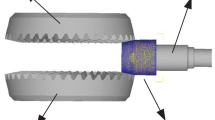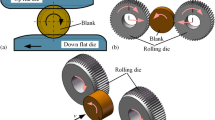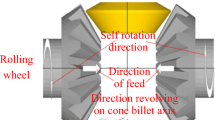Abstract
Gear rolling process is a continuous rolling process by rotating and radial feeding motion of rolling wheel. It has advantages of low manufacturing cost, high gear strength and low forming load. The rolling processes of extrusion forming, gear splitting, continuous rolling and reshaping were analyzed by finite element method. The kinematic relationship between the rolling wheel and the forming gear during rolling deformation was studied. The results showed that the meshing motion between the rolling wheel and the billet could be guaranteed when the initial extrusion of the billet was not less than 1 mm. At the rolling gear splitting stage, the equivalent strain of the billet was shown to be related to the deformation of the material, which attained the largest at the root of the tooth. However, the equivalent stress of the billet was found to be dependent on the contact position of the rolling wheel, which has the maximum value at the root of the tooth in the contact area. During the continuous rolling forming stage, the forming load varied regularly and increased continuously with the rolling feed. The tooth profile of the gear was complete after the rolling reshaping process. According to the analysis and calculation results, the structure of rolling forming device was designed. Experiments showed that spiral bevel gears were able to be formed by rolling, and the billet size had an effect on the rolling process. When the size of billet was about 2 mm larger than the dividing circle radius of target gear, the quality of rolled gear was better. The results have important guiding significance for further research rules of rolling forming processes.


















Similar content being viewed by others
Abbreviations
- m:
-
Modulus of gear (mm)
- r:
-
Gear billet radius
- r p :
-
Radius of pitch circle
- D:
-
Gear center distance
- v :
-
Radial velocity
- i:
-
Transmission ratio
- α:
-
Pressure angle (°)
- α′:
-
Meshing angle (°)
- β:
-
Helical angle (°)
- ∑:
-
Axis intersection angle (°)
- Z:
-
Tooth number
- δ:
-
Cone angle (°)
- δf :
-
Root cone angle (°)
- X:
-
Height of displacement coefficient
- Xt :
-
Tangential displacement coefficient
- ω:
-
Angular velocity (mm/s)
- Fn :
-
Normal load
- Fz :
-
Axial force
- Fr :
-
Radial force
- Ft :
-
Vertical circumferential force
References
Dean, T. A. (2000). The net-shape forming of gears. Materials and Design, 21(4), 271–278.
Zhao, J., Luo, S. M., & Li, F. Q. (2017). Study on precision forming and lift-out process of small cone angle spiral bevel gear by finite element analysis. International Journal of Advanced Manufacturing Technology, 92(5–8), 2559–2568.
Wang, G. C., Li, J., Wu, T., & Yan, K. (2016). Gear rolling technology and its research progress. Aeronautical Manufacturing Technology, 17, 36–40.
Wu, X. Y. (1997). Design characteristics of small modulus involute spline rolling wheel. Mechanical Technician, 1, 15–16.
Domblesky, J. P., & Feng, F. (2002). Two dimensional and three-dimensional finite element models of external thread rolling. Journal of Engineering Manufacture, 216(4), 507–517.
Kamouneh, A. A., Ni, J., Stephenson, D., & Vriesen, R. (2007). Investigation of work hardening of flat rolled helical-involute gears through grain-flow analysis, FE-modeling, and strain signature. International Journal of Machine Tools & Manufacture, 47(7–8), 1285–1291.
Neugebauer, R., Hellfritzsch, U., & Lahl, M. (2008). Advanced process limits by rolling of helical gears. International Journal of Material Forming, 1(S1), 1183–1186.
Khodaee, A., Melander, A. (2013). Finite element simulation as a tool to evaluate gear quality after gear rolling. In Key Engineering Materials, No. 554–557 (pp. 300–306).
Brecher, C., Brumm, M., & Krömer, M. (2015). Design of gear hobbling processes using simulations and empirical data. Procedia CIRP, 33, 484–489.
Sheng, B. Y., & Duan, X. S. (2008). Cold rolling involute tooth profile components rolling round design. Machinery Design & Manufacture, 3, 49–51.
Sun, Y. Z., & Hu, Y. H. (2018). Study on spur-gear rolling and element analysis. Manufacturing Automation, 40(3), 114–117.
Li, Y. Y., Zhao, S. D., Zhao, Y. Q., & Liu, C. (2014). Analysis and experiment on the effect of system parameters on the axial-infeed rolling forming process of spline shaft. Journal of Mechanical Engineering, 54(6), 133–145.
Ma, Z. Y., Luo, Y. X., Wang, Y. Q., & Wang, Y. (2018). Integrity and modeling of gear tooth forming in the roll-forming of gear with axial infeed. Journal of Mechanical Engineering, 50(22), 50–56.
Tang, H. Y., Deng, X. Z., Gao, Z. S., & Zhang, Q. J. (2017). Study on the numerical simulation of hot rolling forming technology of pinion of spiral bevel gear. Journal of Mechanical Transmission, 41(8), 7–10.
Li, J., Wang, G., & Wu, T. (2016). Numerical simulation and experimental study of slippage in gear rolling. Journal of Materials Processing Technology, 234, 280–289.
Gutman, Y., Storm, E. (1989). New approach in die manufacturing for the gear forging process. In Proceedings of the 1989 International Power Transmission and Gearing Conference: New Technologies for Power Transmissions of the 90's (pp. 669–675). Chicago.
Deng, X. B., Hua, L., & Han, X. H. (2011). Three-dimensional FE modeling simulation of cold rotary forging of spiral bevel gear. Ironmaking & Steelmaking, 38(2), 101–111.
Zhu, C. D., Jiang, X., & Dai, T. L. (2015). Research on technology of twin rollers rotary forging of spiral bevel gears. Ironmaking & Steelmaking, 42(80), 632–640.
Cho, H., Shin, Y., Hwang, S. W., Gu, J. H., Baek, J. H., & Kim, J. H. (2015). Finite element simulation of PM gear rolling process. Powder Metallurgy, 58(3), 202–208.
Peng, W. W., Zeng, W. D., & Kang, C. (2011). Development and application of materials database of finite element simulation software deform. Materials Review, 11(2), 131–134.
Acknowledgements
The authors gratefully acknowledge the contribution of the subjects: Natural Science Foundation of Fujian Province of China (Grant No. 2018J01522).
Author information
Authors and Affiliations
Corresponding author
Additional information
Publisher's Note
Springer Nature remains neutral with regard to jurisdictional claims in published maps and institutional affiliations.
Rights and permissions
About this article
Cite this article
Zhao, J., Wang, JH., Li, FQ. et al. Study on Rolling Process Analysis and Experiment of Small Cone Angle Spiral Bevel Gear. Int. J. Precis. Eng. Manuf. 22, 1171–1178 (2021). https://doi.org/10.1007/s12541-021-00497-y
Received:
Revised:
Accepted:
Published:
Issue Date:
DOI: https://doi.org/10.1007/s12541-021-00497-y




